Disclaimer: This product was sent to us for free, in exchange for a review. All opinions expressed in this post are based on our personal views and experiences.
Does The EcoFlow Delta Mini Tick All The Boxes?
Ecoflow is a company that has gone under the radar a little in the solar generator/power station market.
If you have done a lot of research into portable batteries, you might have heard about them, but they’re nowhere near as popular as companies like Goal Zero and Jackery.
That said, their products have been pushing the envelope with innovative products and features in the past couple of years.
I’m going to talk more about what I feel are innovative features in the review, but things like expandability, WiFi-features, third-party solar panel support, high wattage USB C ports, fast charging, and EPS support are the main ones.
The power station I am reviewing in this article has all of those features except expandability.
The Ecoflow power station we have been testing for a couple of weeks and are going to review is the EcoFlow Delta Mini (click to view on Amazon).
Let’s start by taking a closer look at the features, then we’ll dive into what we like and dislike about the Delta Mini.
Features
Last update on 2024-04-25 / Affiliate links / Images from Amazon Product Advertising API
Battery Capacity
The Delta Mini has a battery capacity of 882Wh (watt-hours). The battery type used is lithium-ion.
That means that a fully charged Delta Mini will power a 50W device for almost 15 hours if you take the inverter efficiency into account (85-90%).
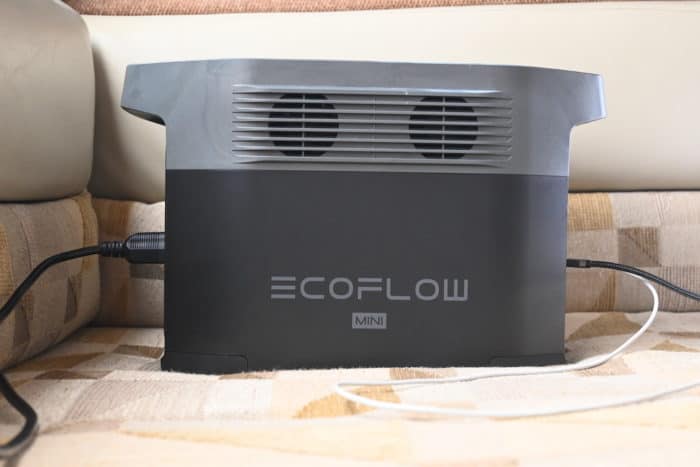
Here are the results of our tests in terms of how long the battery lasted with different products. Some of the numbers have been calculated by using the appliance for a short time.
- 32″ TV (40W) – 19 hours
- Playstation 5 and a 32 inch TV (200W) – 4 hours
- RV microwave (1200W) – 40 minutes
- MacBook Air M1 (45W) – 17 hours
- Space heater on high (1500W) – 30 minutes
- Air fryer (1300W) – 45 minutes
- Gaming Laptop (180W) – 4.5 hours
- Oscillating fan on high (60W) – 13 hours
- Coffee maker (600W) – 80 minutes
If you want to calculate how long the Delta Mini can power one of your devices, the calculation is: 882 divided by the required watts, multiplied by 0.85. For example (882/50W*0.85~15 hours).
You can usually find the required wattage on the device itself or on its power brick. I use a Kill-A-Watt (click to view on Amazon) which tells me exactly how many watts a device is using.
The Inverter/AC Outlets
An inverter turns the 12V DC battery power into 120V AC power, so you can plug in the electronics you usually plug into the wall at home.
The pure sine wave inverter is rated at 1400W, but the Mini has a feature called X-boost which increases the output to 1800W. This feature doesn’t work with appliances that have “strict voltage requirements”, according to Ecoflow.
If you need a power station with a higher rated output, I suggest checking out the EcoFlow Delta Max.
EcoFlow recommends using the X-boost feature with electronics and appliances that have heating elements, although they do not guarantee support for all appliances. The manual advises you to do your own tests to find out what will work and not.
We were able to run our microwave, an airfryer, toaster, and a coffee maker without any problems (not at the same time). Unfortunately, we don’t have any electronics that require over 1500W, so we couldn’t test the X-boost mode fully.
The X-boost mode can be turned on and off in the phone app, but it’s also automatically turned on if it senses that something is trying to pull more than 1400W.
A 1400W inverter is not powerful enough to run an RV air conditioner, but it’s powerful enough to power everything else in our Class C RV, including the electric water heater.
We plugged our RV into the EcoFlow Delta Mini with an 15A to 30A adapter (click to view on Amazon).
If you have a 50A RV, you’d need the 15A to 50A adapter.
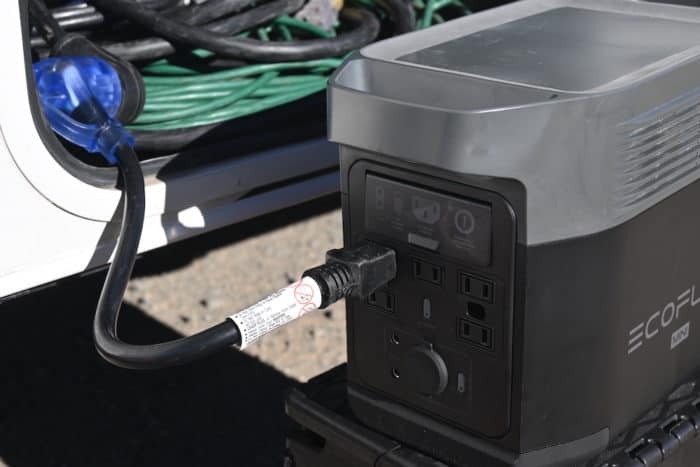
In the EcoFlow app, you can choose to automatically have the inverter turn off after a certain number of hours, or to stay on until you turn it off manually.
EPS
EPS stands for emergency power supply.
This means that you can power your electronics with grid power via the Delta Mini. This is done by connecting the AC wall charger to the Delta, and connecting your electronics to the outlet(s) on the Delta.
The reason that this is not an uninterrupted power supply (UPS) is because it does not support 0ms switching, but 30ms.
This means that if you’re powering something like a desktop computer, the latency will most likely cause the computer to shut down if you lose the grid power.
EcoFlow recommends only charging/powering one device at a time using this feature to avoid triggering the overload protection.
Ports
The Delta Mini has a lot of ports, and can charge/power up to 12 devices at the same time.
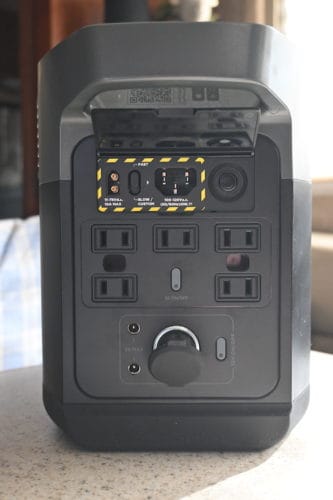
These are the ports:
- 5 AC outlets powered by the 1400W inverter, only two are three-prong. The AC outlets can output 1400W combined, not each.
- Three USB A ports. One is a QC3.0 fast charge port rated at 18W, while the other two max out at 12W
- A regulated 12V cigarette port, rated at 12.6V @ 10A, which equals 126W max.
- Two DC5521 ports
- A USB C 100W port
All the different kind of ports (AC, DC, USB) are turned on and off by the push of a button, or in the mobile app.
The USB ports can be found on the front beneath the display. The rest of the ports are in the back.
The Display
The display shows input/output watts, remaining charge/discharge time, state of charge in percentage and bars, active ports, fan indicator, and warnings.
In the app, you can choose whether you want the screen to turn off after a certain number of minutes/hours, or to always stay on.
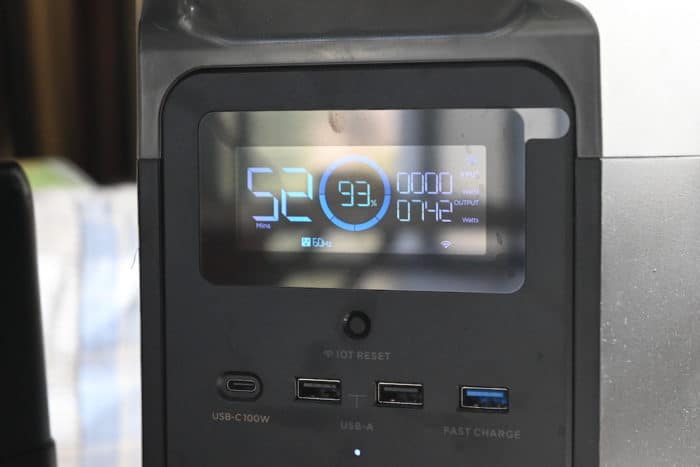
WiFi
What does it mean when a solar generator has WiFi?
Well, in this case it means that the EcoFlow Delta Mini can connect to an available WiFi-network, be it at your home or a mobile hotspot.
It’s setup with the EcoFlow mobile app, which is available on the Apple App Store and the Google Play Store.
When it’s all setup, you’re able to control and monitor the power station. You’re actually able to do several things that you can’t do unless you have the app.
The picture below shows what settings you can change on the Delta Mini with the app.
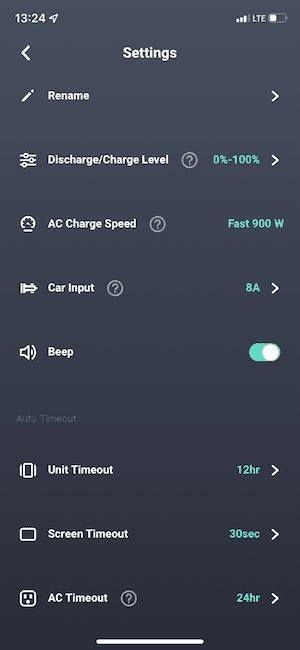
Charging/Solar Capabilities
It only takes 1.6 hours to fully charge the Delta Mini if fast charging is enabled. There is a slide switch on the power station that lets you choose between slow and fast charging.
As I showed in the picture above, the app also lets you choose the AC charge speed. Note that you must slide the switch to “fast” to enable fast charging.
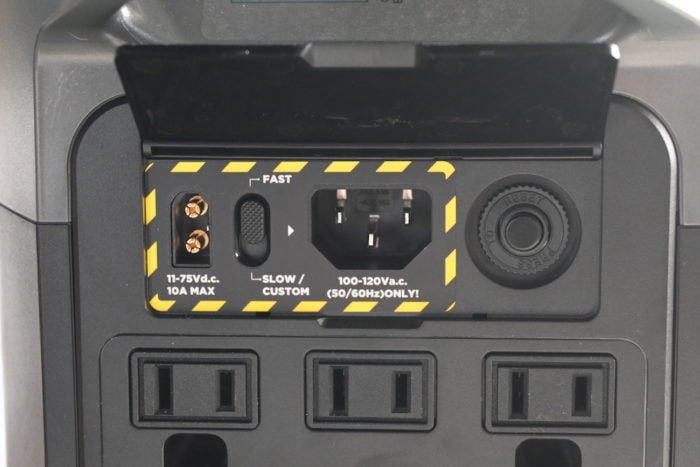
If you use the included car charger, it takes 9.5 hours.
If you’re out in the wild and want to use solar panels, it’s going to take 3-6 hours with 400W solar. With a single 100W panel, it takes close to 12 hours.
The solar charge controller is an MPPT controller. It can handle voltages between 11-75V, 10A, with a 300W maximum.
Note that due to the 10A limit, a single large panel (200W for example) might not be the best panel to connect since it could reach the 10A limit and waste some of the electricity generated. It’s safe though.
It would be a better idea to get two 100W panels and connect them in series, then connect the pair to the Delta Mini. That way, the total voltage put out by the panels will be within the 11-75V range, and less than 10A.
A parallel connection adds the amperages together but keeps the voltage the same. A series connection adds the voltages together, but keeps the amperage the same.
It’s very important to know the total voltage that your panels are going to be outputting, before connecting it to the power station input. Check the specifications of your panel and combine the open circuit voltages.
The good news is that EcoFlow includes an MC4 to XT60 adapter, so it’s ready for third-party solar panel right out of the box.
EcoFlow makes and sells a 110W solar panel, and a 160W solar panel. This connects to the Delta Mini with the use of the included MC4 to XT60 adapter.
Some of the third-party solar panels that are compatible and popular are the Rockpals 100W, the rigid Renogy 100W, the flexible Renogy 100W, and the Rich Solar 200W.
To connect two panels together, you can use an MC4 Y branch for a parallel connection. A parallel connection adds the amperages together while keeping the voltage the same.
I recommend doing a series connection though, because of the 10A max input.
A series connection is made by connecting the positive MC4 connector from one panel to the negative Mc4 connector on the second panel. You’ll end up with a negative wire from the first panel, and a positive from the second one, which is what is plugged into the MC4 to XT60 adapter.
A series connection adds the voltages together, but not the amperage. Therefore, you need to make sure that the total voltage (panel 1 VOC + panel 2 VOC) is within the 11-75V range.
If you’re not sure if a specific panel or setup is compatible, please leave a comment and I’ll do my best to help you figure it out.
In The Box
EcoFlow includes an AC cable, car charger, MC4 to XT60 adapter, a DC 5.5×2.1mm to 5.5×2.5mm cable, and a manual.
Weight & Size
The Delta Mini weighs 23.6 pounds (10.7 kg) and measures 14.9 by 7.2 by 9.4 inches.
Our Review Of The EcoFlow Delta Mini
What I Like
Powerful Inverter
The 1400W inverter can power everything in my RV except the air conditioner. That’s all I need from a portable power station.
With the X-boost mode pushing that number to 1800W, there aren’t a lot of things that this inverter won’t be able to run.
Most of the electronics and appliances in the 1400 to 1800 watt range are the type of things that the X-boost mode supports, like countertop burners, coffee makers, microwaves, electric grills, air fryers, and similar kitchen appliances.
Extremely fast charging
The X-stream technology that charges the battery from 0 to 80% in 1 hour is one of those innovative features I was talking about in the intro.
As an RVer, that means I can use the battery for a couple of days when we only need to keep our electronics charged. We do turn off the inverter when we’re not using it.
We turn on/off the converter charger in our RV as needed. We do have a separate 100W panel on the roof charging our house battery, but when it’s cloudy we let the EcoFlow charge it up.
Then when the EcoFlow is getting low, I can fire up my generator for an hour (or 1.6 hours for a full charge), and be ready to go again.
If you’re an RVer that plan on using it this way, I highly recommend getting either a portable Renogy 100W panel that is ready to be connected to a 12V battery, or a 100W solar panel kit.
Of course, if you have solar panels you might never need to turn on your generator again depending on your electricity needs.
This makes it a great power station for not only RVers, but car- and van-campers.
It would’ve been great if it would accept more than 300W when using solar panels as well, but it’s still better than what some of its competitors can do.
Last but not least, the AC charging cable doesn’t come with a massive power brick, it’s just the cable.
Lots of ports
We have already concluded that there are a lot of ports on the Delta Mini. They did a great job when designing this power station, and I haven’t seen any other power station that comes close in terms of ports.
100W USB C
The USB C port is a powerful one, and great for somebody like me that has a laptop that charges via USB C.
It’s not only about convenience but efficiency since turning on the inverter would be less efficient than charging via USB.
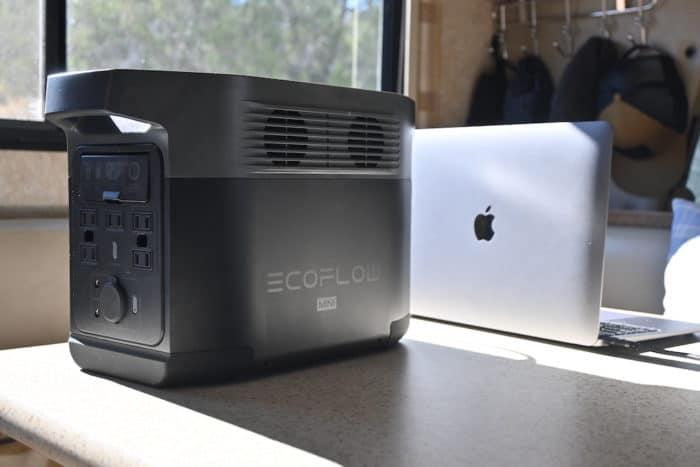
Can be controlled and monitored with phone app (WiFi support)
The EcoFlow app has worked great for me, better than I expected, and now I don’t want a power station that I can’t control from my bed.
I have it setup with my mobile hotspot that we always leave in the RV, and it works even if we’re away from the camper as long as both the hotspot and my phone has cell service.
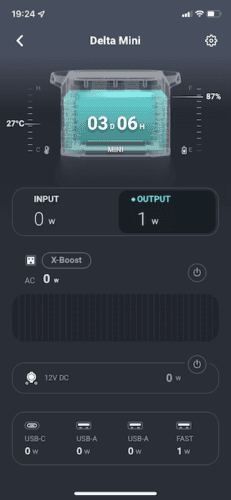
Regulated 12V port
A regulated 12V port puts out a consistent voltage, which some sensitive appliances require.
This is essential if you plan on using a 12V fridge/freezer with your power station.
The included cables and adapters
Every other power station we have tested and reviewed has had a large power brick that has gotten extremely hot and been in the way.
The EcoFlow Delta Mini simply has a power cable that plugs straight into the power station.
A car charger is also included, which is great.
I also appreciate that EcoFlow includes the MC4 to XT60 adapter.
EPS Support
It’s not a UPS, but an EPS. Still, if you plan on using it at home to keep your devices powered, it’s much better than charging/discharging the battery all day every day, since that would cause a lot of unnecessary battery wear.
Design & Portability
I like the design a lot and the built-in handles that aren’t over-the-top. It’s very portable and easy to carry around.
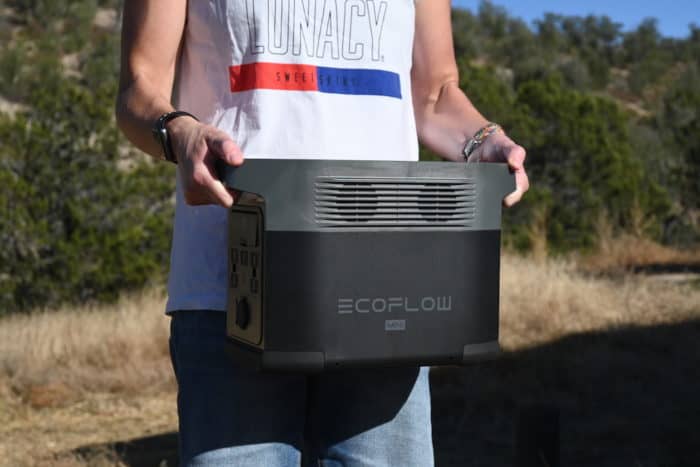
Having the USB ports and the display on the opposite side of the AC outlets and the inputs is genius. Some may not like it, but in the RV it keeps everything looking cleaner and less messy.
What I Don’t Like
Only two of the outlets are three prong
The Delta Mini has a lot of AC outlets (5), but there is only space for two three prong appliances. I understand that it’s due to space limitations, but still.
Can’t charge via USB C
The USB C port is powerful when it comes to outputting watts, but it can’t handle input. Since I have some powerful USB C PD chargers, it would’ve been awesome if this port supported input as well.
Doesn’t use a common solar input
The XT60 connector is not a proprietary connector by any means, but it’s not a connector that’s included with most of the portable solar panels on the market.
It’s great that an MC4 to XT60 adapter is included, but that still requires a panel with MC4 connectors.
The fan could be quieter
Power stations have fans built-in to keep the unit and its parts cool when charging/discharging. The one in the Delta Mini is a little sensitive and you’re going to hear it pretty much anytime you use the inverter.
In a way, it’s great that it’s sensitive because you don’t want the batteries to get hot, but it’s something to be aware of.
Conclusion
The EcoFlow Delta Mini is simply one of the best power stations that we have ever tested.
It’s a combination of intuitive features and a lot of thought behind what goes in it and where. It’s the complete power station for travelers like us.
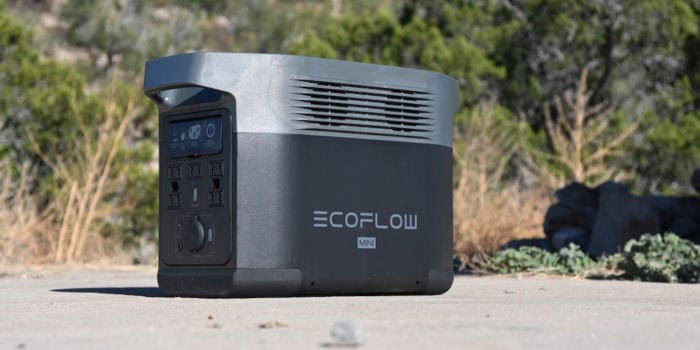
Most of the time, a good power station is missing something specific that keeps it from being great.
That’s not the case here, and the only thing we really want more of from the Delta Mini is battery capacity, but that’s why Ecoflow also makes the Delta Max and Delta Pro. The larger models can also handle more solar panels.
All in all, I don’t see how you’re going to be disappointed with the Delta Mini, as long as you understand its features and limitations.
Frequently Asked Questions about the Ecoflow Delta Mini
Can you fast charge with solar panels?
The max solar input is 300W. The 900W fast charging can only be accomplished with the power cable and a power source capable of outputting at least 900W, like a gas generator or a regular 15A outlet.
Can you use the outputs while the battery is charging?
Yes.
Can you connect two Delta Mini power stations together?
No, you can not combine two or more of these.
Can it run an RV AC?
No, the most common RV AC (13,500 BTU) requires more than the rated 1400W.
Have any more questions about the Ecoflow Delta Mini review? Leave a comment below.




Hi Jesse,
I have a Renogy 200W Monocrystalline Solar Panel (RSP200D-G1). But I can only get a maximum of 115W under the best sunny condition to my Ecoflow Delta mini power station. Although Ecoflow said they have MPPT controller built in, but I doubt about it. Before buying this Ecoflow delta mini, I also tried JACKERY EXPLORER 880 with the same solar panel and got about 145W maximum power. Although both companies claim they have MPPT built in, Jackery is better (still far below 200W) than Ecoflow battery. Do you know how to improve solar efficiency ?
Hi Rongfu,
Yep, that’s because of the 10A limit. Most power stations can handle more amperage but are limited when it comes to voltages, Ecoflow’s products are the opposite.
Because of this, even having two 100W panels wired in series would be better than a single 200W panel. Since the total voltage would be within the 11-75V DC range that the Delta Mini accepts, and not waste any electricity because the amperage would still be what one panel outputs, around 5-6 amps.
Now, if you bought another 200W panel and wired it in series to your first panel, it would charge very quickly.
Thanks for your comment, I am going to add this to the article to make it clear how it can be a downside.
with such Renogy 200W Monocrystalline Solar Panel (RSP200D-G1) and Ecolflow delta mini, I even cannot keep my 40W refrigerator running overnight. It is really bad!!!
Perhaps your refrigerator is not cooling properly. I just got a mini, tried running our new chest freezer in the garage – it is 100W when it’s running. Over 12 hours it used about half the battery. I suspect I can get a full charge with 100+/- solar in four or five hours. I’m thinking as long as there was sun it could sustain operation indefinitely.
A refrigerator should not run more than 40-50% of the time – less is more.
Thanks for this great review. My question relates to hooking up my existing solar panels to this unit (which I just ordered). I have the Renogy 100 Watt 12 Volt Monocrystalline with 20A Charger Controller. Am I to assume I have to perform the Charge Controller bypass procedure that you detail in one of your other articles to make this operation work correctly? Or is it better to bite the bullet and purchase some new panels? Thanks in advance!
Hi Woody,
Yes, you’re correct that you need to bypass the charge controller.
If you’re going to use the panel with a 12V battery and the Ecoflow and disconnect it regularly I would get a second panel.
Otherwise I’d just get an MC4 kit and get it done. It’s easy to do but it’s important that you know what you’re doing.
When you say you can connect your battery Delta mini to your RV for about 2 days before charging, does this include this shore power battery is charging your trailer battery at the same time? Isn’t the converter on the trailer a large draw to charge the trailer battery on the Delta?
Hi, thanks for your comment. I have made that section more clear and added more information.
We keep the converter charger turned off most of the time because we have a 100W panel on the roof that charges our house battery. There is a switch on the breaker panel at least in our RV that makes that easy.
Also, we turn off the EcoFlow inverter when we’re not using it, otherwise it would drain the battery a lot quicker.
When we do use the EcoFlow to charge the house batteries when it has been cloudy for a day or two, it takes from 50-300W and drains the battery quickly.
However, if it is sunny and our batteries are close to full, we can leave the converter charger on and it doesn’t take much electricity from the power station at all.
This should’ve obviously been explained better, sorry about that.
Thanks Jesse for the added explanation. I do have a battery cutoff switch at the front of the trailer and as for the converter panel not sure I have a breaker for that yet as my trailer is in storage for another few weeks. I sense if I cutoff the battery switch the trailer converter will only draw a small amount of power to keep the 12V items powered. I’m looking forward to testing this. It’ll be nice to connect the power station to the 30A connector and provide power to the 120V outlets as needed inside, microwave, coffee maker & CPAP machine, etc.
Hello, I am preparing a van to travel and I am considering buying an ecoflow delta mini and two 100w solar panels to have a 12v refrigerator with a compressor of about 50-60w and that can charge the phone. I work in the field and I use battery-powered machinery, so I could take advantage of the fact that ecoflow is portable, in the field I use two 281wh batteries (30×3.6vx2.6ah).
It’s a good idea? I live in Spain
Hi,
Yes, the Delta Mini would be great for that. But I would want to make sure that the refrigerator won’t be draining the battery within a day before buying the Delta. Can you find any information about the total watt-hours required to run the fridge for 24 hours?
Hello! Thank you very much for answering, the refrigerator model would be an Alpicool CF55 of 60 wh
Ok, yes the Delta Mini should be able to run the CF55 for 3-4 days.
With two 100W panels (I suggest wiring them in series btw) it will run forever as long as you don’t have more than two or three cloudy days. But since you’re going to be in a van you can use the included car charger to top it off as needed.
I haven’t tested it myself, but that’s what I would expect from the setup. Please let me know if my estimates end up being way off so I know for future reference, thanks.
Perfect, I’m thinking if I can connect the solar panels and the cigarette lighter charger at the same time and thus forget about the connections while I travel, is it possible?
Unfortunately not, since they share the same input.
Thank you very much for all the information
Hello again! As I move forward with the project to transform the van, I find myself with many questions. Now I would like to have a 32w engel mr40 fridge, a 28×28 25w Fiamma Turbo Vent skylight, a 20w water pump, be able to charge a mobile phone (15w) and have some Led light (15w). I have calculated an hourly use and more or less I would get a daily consumption of 47.1 amps (565.2w) if I have done it right. That energy could be given by the mini delta battery with the two 100w solar panels? Could I connect all this to the battery or do I need some type of adapter for example to connect the pump or the skylight, in the end there are 4 fixed elements, or would it be better to make a 12v electrical installation with a gel battery? For me it is convenient to have a battery like the delta mini because I don’t know how to do the electrical installation and the two options have the same final price of about €1,500.
Hi,
It depends on how the skylight and water pump come wired, if they come with bare 12V wires you can get some adapters to connect it all to the EcoFlow. If they come with AC plugs, they’ll plug right in. If you can
provide me links to the things you want to connect I’ll take a look.
As the van is small (mercedes sprinter L1H1) I am going to simplify and put a fanless skylight and a window in the rear door so I have air flow. I have seen that for the water pump there are 2 options, submersible or external, which you recommend for a single sink faucet to connect to the delta mini. I have already greatly reduced the need for energy. Another question I have, is two 160w solar panels better? Or two of 110w
I cannot find any information where and how you connect a 12v tv with a two pin plug into the ecoflow,all the information I can read is about charging the ecoflow.The small 12v tv is the most important gadget in my campervan for my wife,and the biggest consumer of my leisure battery
Hi,
I don’t know what the two pin plug looks like, can you tell me which TV you have so I can look it up? Or a link to a picture of the plug.
Hi Jesse! I just found the 1000wh Zendure SuperBase M that can be charged with solar panels and with the car at the same time, that seems very interesting, ecoflow delta mini cannot, it is in the same price range and with more power, what do you think? Sorry for so many doubts I have and so many questions
Hi,
Yeah, it seems alright. If that’s an important feature to you then it’s definitely a better option. Wish it had more AC ports, but you can always use a power strip. More watt-hours but a weaker inverter.
Hi Jessie
I just ordered a Delta Mini. I have an Offgridtec FSP-2 120w kit with a Victron smart solar 75/15 mppt that is used to keep our leisure battery charged. The solar panel has an Anderson connection. What adapter would I need to connect the solar panel to the Delta mini?
Hi,
If it’s the Anderson Powerpole connector you’ll just need an Anderson to XT60 adapter (click to view on Amazon). Make sure the polarity is correct (positive to positive, negative to negative), and to connect the panel directly to the Delta without the charge controller.
Thanks Jessie! The Anderson connector is a grey connector…not sure which type as I’m very new to this stuff. I’ve ordered this: https://www.offgridtec.com/offgridtecr-adapterkabel-anderson-auf-xt60-20cm.html
Hopefully it’s correct.
Thanks for the help great blog! David
Hi,
Ah gotcha, it’s not the Powerpole type. That one should work great, good find!
Please give your opinion on this panel, would it work well with the mini?
ELECAENTA 300W Portable Solar Panel, Ultra-Light/ Only 13.9lbs, Flexible & Foldable Monocrystalline ETFE Solar Charger with Kickstand, IP54 Waterproof for Outdoors RV Camping Off Grid Adventures https://a.co/d/9bXyhQa
Hi,
Yes, that looks like an excellent choice for the Delta Mini. High voltage rating and an amperage rating below 10A, nice find!
Hello,
Would a solar panel with these specs be safe and efficient to plug into the Delta Mini?
Solar Cell – Monocrystalline
Conversion Efficiency – up to 24%
Max Power – 300w
Power Voltage – 39V
Power Current – 7.69A
Open Circuit Voltage – 47.65V
Short Circuit Current – 10.1A
Hi,
Yes, that looks like a great choice for the Delta Mini.
Hi,
I have the Delta mini, and will occasionally use it for shore power. I’ve never done that before, so partly I just want to know – what do I need to worry about? I know the trailer battery’s will pull energy, and I know I can’t use the microwave and AC. But, is there something I should be watching for (on the app) in terms of it being overused or malfunctioning? I like to know what could go wrong…Thanks!
Hi,
If the temperature warning shows up on the screen or in the app because it’s hot in your camper and the inverter is working hard, you could unplug it for a while just to cause less stress on the batteries.
But the Delta Mini has a lot of safety features built-in. If it got so hot that it could permanently damage it, it would shut itself down. So you don’t need to worry about it.
Even if you would try to run the microwave, for example, the inverter will simply shut down and reset the outlets on the Delta. It wouldn’t permanently damage it.